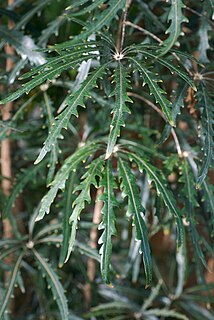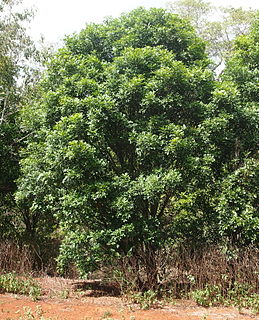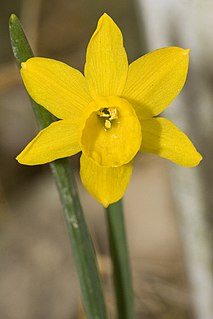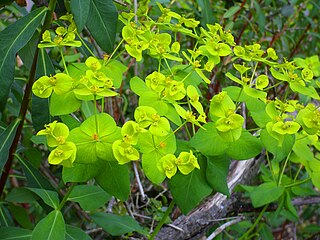Cycas calcicola is a species of cycad in the genus Cycas, native to northern Australia in the northwest of Northern Territory.

Plerandra is a genus of flowering plants in the family Araliaceae that has long been considered a synonym of Schefflera, which has been a polyphyletic group.

Atalaya is a genus of eighteen species of trees and shrubs of the plant family Sapindaceae. As of 2013 fourteen species grow naturally in Australia and in neighbouring New Guinea only one endemic species is known to science. Three species are known growing naturally in southern Africa, including two species endemic to South Africa and one species in South Africa, Eswatini and Mozambique.
Inga calcicola is a species of plant in the family Fabaceae. It is found only in Mexico.
Ormocarpopsis aspera is a species of flowering plant in the family Fabaceae. It is found only in Madagascar.
Ormocarpopsis is a genus of flowering plants in the family Fabaceae, and was recently assigned to the informal monophyletic Dalbergia clade of the Dalbergieae. It contains the following species:
Ormocarpopsis itremoensis is a species of flowering plant in the family Fabaceae. It is found only in Madagascar.
Ormocarpopsis mandrarensis is a species of flowering plant in the family Fabaceae. It is found only in Madagascar.
Ormocarpopsis parvifolia is a species of flowering plant in the family Fabaceae. It is found only in Madagascar.
Ormocarpopsis tulearensis is a species of flowering plant in the family Fabaceae. It is found only in Madagascar.

The variable limestone babbler is a species of bird in the family Pellorneidae. It is found in the limestone hills of northern and eastern Thailand northwest to southern Myanmar. Two other Gypsophila species, the Annam limestone babbler and the rufous limestone babbler were previously considered subspecies of crispiforns, but a 2020 study found them to be distinct species.
Madhuca calcicola is a species of plant in the family Sapotaceae. It is a tree endemic to Peninsular Malaysia. It is threatened by habitat loss.
Myrcia calcicola is a species of plant in the family Myrtaceae. It is endemic to Jamaica and is threatened by habitat loss.
Toxicodendron calcicolum is a species of plant in the family Anacardiaceae. It is endemic to China.
Shorea calcicola is a species of plant in the family Dipterocarpaceae. The species name is derived from Latin and refers to the preferred habitat of this species. It is a medium-sized tree, usually less than 50 metres (160 ft) tall, found in mixed dipterocarp forest on organic soils over limestone. S. calcicola is endemic to Borneo.

Narcissus calcicola is a species of narcissus (daffodils) in the family Amaryllidaceae. It is classified in Section Apodanthi. It is endemic to Portugal.

Eucalyptus calcicola, commonly known as the Boranup mallee, Harry Butler's mallee or Hamelin Bay mallee, is a mallee that is endemic to a small area in the south-west of Western Australia. It has smooth, pale greenish bark, lance-shaped to curved adult leaves, flower buds in groups of seven or nine, white flowers and ribbed, cup-shaped to hemispherical fruit.

Euphorbia paniculata is a species of flowering plant in the spurge family Euphorbiaceae, native to the Iberian Peninsula and North Africa in the western Mediterranean Basin.
Magnolia fulva is a species of flowering plant in the family Magnoliaceae, native to south-central China and Vietnam. It was first described, as Michelia fulva, in 1987.






